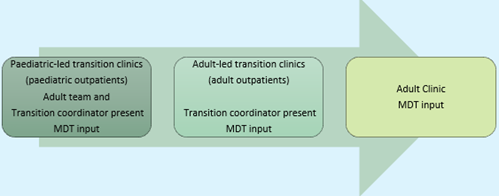Respiratory Futures recently spoke to Alexandra Nanzer, Consultant Respiratory Physician and Lead for Asthma Transition, and Louise Thomson, Clinical Nurse Specialist (CNS) in Severe Asthma and Transition Co-ordinator, from Guy’s and St Thomas’ NHS Foundation Trust. Alexandra and Louise talk to us about the transition from paediatric to adult care in asthma, and how to ensure this process best works for patients.
Can you tell us a little about what transition care for asthma looks like as a service pathway?
AN: Transition care should start in dedicated and joint paediatric and adult transition clinics. From the age of 13-14, adolescents are seen in their familiar outpatient environment within the children’s service with the adult team present. Over a series of paediatric-led joint appointments, the patient and their family or carers get to meet the adult team, and likewise, we get to know the patient and their family, as well as their asthma disease characteristics, comorbidities, mental health, and social and family background. Transition readiness questionnaires can help establish whether further input from paediatric teams or the wider MDT would be helpful prior to arranging a first appointment in the adult service.
LT: Once the patient is ready to transition to the adult service, I arrange a date for them to visit the adult out-patient and A&E departments for an informal ‘walk-around’ to familiarise themselves with the adult hospital environment. We have found it helpful for patients to have a first date in their diary by the end of the last paediatric-led transition clinic appointment. Our centre follows our own transition protocol, which is completed by the paediatric transition team prior to the first adult appointment. This protocol includes a form with a variety of different checkpoints, including diagnosis, medications, lung function, social situation, lifestyle choices, education and knowledge, self-advocacy and biologics.

Why is transition care a vital part of asthma management? What impact can it have on patients?
AN: Asthma prevalence and mortality amongst adolescents has remained high for decades. Rates of A&E attendances for asthma exacerbations are higher than either younger or older age groups, and too often adolescents get lost to regular follow up as they outgrow paediatric services.
LT: Young adults with asthma are having to learn how to independently manage a chronic illness whilst navigating the complexities of adolescence. Data suggest HCPs do not support self-management well enough. We expect adolescents to attend appointments, order and adhere to medication, manage drug side effects, and consider emerging physical and psychiatric co-morbidities.
AN: Transition clinic appointments not only review asthma biomarkers but focus on teaching young people the skills to independently manage their asthma and make achievable choices irrespective of their asthma severity. Having a dedicated asthma transition team to turn to helps young adult patients to stay engaged.
What are some of your top tips in setting up and running a transition service?
AN: Transition needs to be planned, age-appropriate and effective. This can be best achieved by having a named transition lead within both the paediatric and adult services, job planned and appropriately funded.
Some young adults will benefit from seeing one or multiple members of the MDT including physiotherapists, speech therapists, psychologists, dieticians and pharmacists. A transition co-ordinator will support communication between the young adult and different specialists across paediatric and adult services.
LT: From the first paediatric led transition clinic, young adults know I will be their transition co-ordinator, that I am here to help them navigate through the transition process and into adult care for as long as necessary. I have a dedicated weekly transition clinic slot for our young adult patients, who make use of this slot to not only have their asthma symptoms reviewed, but also to ask for advice on how to order repeat prescriptions, get mental health support or how to re-arrange appointments, for example. The service has a nurse helpline, and young adults can call or send a text message in between appointments to gain easy access to asthma advice and reviews where required.
Why is it important to take a multi-disciplinary team approach to transition care for asthma?
AN: Adolescence is a critical time of change, and asthma can change during adolescence. Risk taking behaviour increases and can affect treatment adherence and mental health, which in turn affect asthma control. Hormonal or weight changes may affect symptoms, as will new occupational or environmental exposures. Whilst not all patients need an equal amount of support, outcomes improve for those who are able to see a health psychologist, physiotherapist, SALT or a dietician when needed. Our pharmacist offers adherence support and will always try and simplify medication regimes, for example.
LT: During the transition period I will align the input of the wider paediatric MDT to the adult MDT. As time evolves, the young person’s needs may change and we will discuss this regularly and ensure they have access to different HCPs.What are some of the main things other health professionals can do to ensure the transition care they provide is safe and effective?
AN: Transition care is more than just transfer of care via referral letter. It is a planned process, which may take longer for some than for others. Patients and their families must be fully involved in decision making. There should be a strong focus on education and self-management, allowing young adults to take control. Until very recently, most parents or carers will have managed every aspect of their asthma – this needs to change during the transition period.
LT: As the transition coordinator, I get to know the young adult and their family over a series of appointments, and I am able to provide personalised care and ensure continuity. By the time they have their first adult appointment, they are familiar with their adult transition team, and this supports engagement and reduces non-attendance rates.



